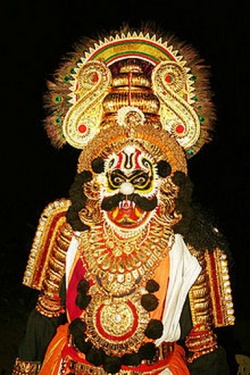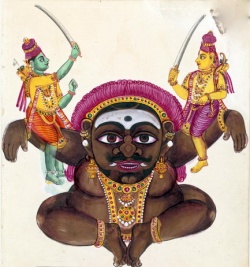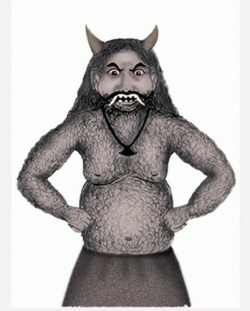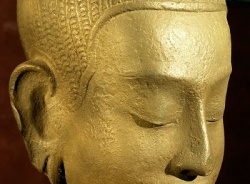Rakṣasa
rakṣasa (羅剎). A demonic Ghost that eats human flesh. Rakṣasas are said to be the original inhabitants of Sri Lanka.
In Hindu Lore
Vedic / Puranic Stories
Death of Hiranyaksha, the son of Diti
Their origin cannot be traced back to the vedic times. During the vedic times, there were only two people in question. Those were the Asuras and the Devas. It was much later that the concept was re-invented to put the Asuras in the Rakshasa group. This is supported by the fact that the word Rakshasa was not used until much later times. So only Asuras may be traced back to the vedic times during which the Asuras and the Devas were on nearly equal footing.
The tracing back to Kashyapa is a later editing (clearly post vedic). Kashyapa was married to the thirteen daughters of Daksha, among them were Aditi, Diti and Danu.
The sons of Kashyapa with Danu are the Danavas (meaning of Danu).
The sons of Kashyapa with Diti are the Daityas (meaning of Diti).
The sons of Kashyapa with Aditi are the Adityas (meaning of Aditi). The Adityas are Devas (deities), also known by other names such as Suras.
Rakshasa were most often depicted as mean, fierce looking, ugly, large as hills, black as soot, with two fangs protruding down from the top of the mouth, having sharp claw-like fingernails, and growling like beasts. They were also depicted as cannibals with an insatiable hunger, who could smell the scent of animal, men or flesh. Some more ferocious ones were shown with flaming red Eyes and flaming Hair, drinking blood with their palms or from a human skull(in their such description very much similar to 'Vampires' of Christian mythology). Generally in mythical tales, they had the Power to fly, could vanish and also increase or decrease their size at will. They could also take the Form of any animal, human or other thing at their will. These powers were called Maya(some kind of powerful 'Magic').
In the Hindu epics
Krishna orders Mayasura to build a palace for the Pandavas
In the World of the Ramayana and Mahabharata, Rakshasas were a populous race of supernatural humanoids. There were both Good and Evil rakshasas, and as warriors they fought alongside the armies of both Good and Evil. They were powerful warriors, expert magicians and illusionists. As shape-changers, they could assume various physical forms, and it was not always clear whether they had a true or natural Form . As illusionists, they were capable of creating Appearances which were real to those who believed in them or who failed to dispel them. Some of the rakshasas were said to be man-eaters, and made their gleeful appearance when the slaughter on the battlefield was at its worst. Occasionally they serve as rank-and-file soldiers in the service of one or the other warlord.
Aside from its treatment of unnamed rank-and-file Rakshasas, the epic tells the stories of certain members of the race who rose to prominence, some of them as heroes, most of them as villains.
In the Ramayana
The Battle of Lanka pitted an army of Rakshasas under Ravana against an army of Vanaras or monkeys under Rama and Sugriva.
Ravana
Taraka
Ravana, a Rakshasa with 10 heads, was the King of the Rakshasas and the mortal enemy of Rama, the hero of the Ramayana. In the Ramayana (Book III: Vana Parva, Section 271 ff.), the Sage Markandeya recounts the story of how Ravana kidnapped Rama's wife Sita and whisked her off to his stronghold Lanka, and how Rama, aided by the monkey King Sugriva and his army of monkeys, laid siege to Lanka, slew Ravana, and rescued Sita.
Vibhishana, Ravana's younger brother, was a rare good-hearted Rakshasa; he was beautiful, pious and assiduous in his religious observances. When Brahma granted him a boon, he asked never to swerve from the Path of righteousness and to be illumined by divine Knowledge (Book III, Vana Parva: Section 273.) Vibhishana joined Rama in his campaign against Ravana, and helped Rama's army to cross the ocean into Lanka (Section 281). When invisible Rakshasas infiltrated Rama's camp, Vibhishana caused them to become visible, and Rama's monkey soldiers destroyed them (Section 283). After Rama's final victory over Ravana, the loyal Vibhishana was made king of Lanka (Section 289).
Kumbhakarna was another brother of Ravana. A fearsome warrior and master of Illusion, he slept through most of the Battle of Lanka (having long before requested and received a gift of long-lasting sleep from Brahma), but arose and took the field when Ravana Awakened him with alarming news about the progression of the conflict. Upon marching out of the city, Kumbhakarna was immediately swarmed by Rama's monkeys, causing him only to laugh and to wreak great mayhem among them. When the monkey king Sugriva attacked, Kumbhakarna grabbed him and started to drag him off. It was at that point that Rama and his brother Lakshmana used arrows and a secret Brahmastra ("Brahma's weapon") to kill Kumbhakarna, dropping the Rakshasa like a huge tree cleft in twain by a thunderbolt. (Ramayana, Book III: Vana Parva, Section 285.)
Other Rakshasa that appear in the Ramayana include Kabandha, Tataka, Surpanakha, Maricha, Subahu, Khara, Indrajit, Prahasta, Akshayakumara and Atikaya.
In the Mahabharata
The Pandava hero Bhima was the nemesis of forest-dwelling Rakshasas who dined on human travellers and terrorized human settlements.
Hidimba was a cannibal Rakshasa who was slain by Bhima. The Mahabharata (Book I: Adi Parva, Section 154) describes him as a cruel cannibal with sharp, long teeth and prodigious strength. When Hidimba saw the Pandavas sleeping in his forest, he decided to eat them. He made the mistake of sending his sister Hidimbi to reconnoiter the situation, and the damsel fell in Love with the handsome Bhima, whom she warned of the danger. Infuriated, Hidimba declared himself ready to kill not only the Pandavas but also his sister, but he was thwarted by the heroism of Bhima, who defeated and killed him in a duel.
Hidimbi - the sister of Hidimba
Ghatotkacha, was the son of Bhima and Hidimbi. His name refers to his round bald head with ghata meaning pot and utkacha meaning head in Sanskrit.
Ghatotkacha, when he was young, lived with his mother Hidimbi, when one day he had a fight with Abhimanyu, his cousin, without knowing that Abhimanyu was Arjuna's son.
Ghatotkacha is considered to be a loyal and humble figure. He made himself and his followers available to his father Bhima at any time; all Bhima had to do was to think of him and he would appear. Like his father, Ghatotkacha primarily fought with the mace.
His wife was Ahilawati and his son was Barbarika.
In the Mahābhārata, Ghatotkacha was summoned by Bhima to fight on the Pandava side in the Kurukshetra battle. Invoking his magical powers, he wrought great havoc in the Kaurava army. In particular after the Death of Jayadratha, when the battle continued on past sunset, his powers were at their most effective (at night).
At this point in the battle, the Kaurava leader Duryodhana appealed to his best fighter, Karna, to kill Ghatotkacha as the whole Kaurava army was coming close to annihilation due to his ceaseless strikes from the air. Karna possessed a divine weapon, Shakti, granted by the God Indra. It could be used only once, and Karna had been saving it to use on his arch-enemy, the best Pandava fighter, Arjuna.
Unable to refuse Duryodhana, Karna used the Shakti against Ghatotkacha, killing him. This is considered to be the turning point of the War. After his Death, the Pandava counselor Krishna smiled, as he considered the War to have been won for the Pandavas now that Karna no longer had a divine weapon to use in fighting Arjuna.
There is a temple built in Manali, Himachal Pradesh for Ghatotkacha near Hidimba Devi Temple.
Kamsa was the brother of Devaki. Kamsa was a cruel Rakshasa who killed his sister's children because he Thought that his Death would be caused by one of her children. Vasudeva, husband of Devaki was able to save one of her children. That child's name is "Krishna".
Bhima fighting with Bakasura color
Bakasura was a cannibalistic forest-dwelling Rakshasa who terrorized the nearby human population by forcing them to take turns making him regular deliveries of Food, including human victims. Unfortunately for Bakasura, the Pandavas travelled into the area and took up residence with a local Brahmin whose turn had come up to make the delivery. As the Brahmin and his family debated which one of them would have to be sacrificed, the rugged Bhima volunteered to take care of the matter. Bhima went into the forest with the Food delivery (consuming it on the way to annoy Bakasura) and engaged Bakasura in a ferocious wrestling match, which ended with Bhima breaking his opponent's back. The human townspeople were amazed and grateful, and the local Rakshasas begged for mercy, which Bhima granted them on the condition that they give up cannibalism. The Rakshasas agreed to the proposal, and soon acquired a reputation for being peaceful towards humans. (Book I: Adi Parva, Sections 159-166.)
Kirmira, the brother of Bakasura, was a cannibal and master illusionist. He haunted the wood of Kamyaka, dining on human travellers. Like his brother before him, Kirmira made the mistake of fighting the Pandava hero Bhima, who killed him with his bare hands (Book III: Varna Parva, Section 11).
Jatasura was a cunning Rakshasa who, disguised as a Brahmin, attempted to steal the Pandavas' Weapons and to ravish their wife Draupadi. Bhima arrived in time to intervene, and killed Jatasura in a duel. (Book III: Varna Parva, Section 156). Jatasura's son was Alamvusha, who fought on the side of the Kauravas at Kurukshetra.
Rakshasa heroes fought on both sides in the Battle of Kurukshetra.
Ghatotkacha, a hero fighting on the side of the Pandavas, was the son of Bhima and the Rakshasa woman, Hidimbi, the sister of a being slain by Bhima. After performing many heroic deeds on the battlefield and fighting numerous duels with other great warriors (including the Rakshasa Alamvusha, the elephant-riding king Bhagadatta, and Aswatthaman, the son of Drona), Ghatotkacha was himself slain by the human hero Karna. In order to defeat Ghatotkacha, Karna found himself compelled to use a one-time secret weapon that he had been intending to reserve for use against his bitter rival Arjuna. When Arjuna defeated Karna in battle, it was in no small part because Karna had already expended his secret weapon. (Book VII: Drona Parva, Section 179.)
Alamvusha was a Rakshasa skilled at fighting with both conventional Weapons and the powers of Illusion. According to the Mahabharata, he fought on the side of the Kauravas. Arjuna defeated him in a duel (Book VII: Drona Parva, Section 167), as did Arjuna's son Abhimanyu (Book VI: Bhishma Parva, Section 101-102). However, Alamvusha was able to kill Iravan, Arjuna's son by a Nāga princess Ulupi, when the Rakshasa used his powers of Illusion to take on the Form of Garuda. Alamvusha was also defeated by Bhima (Book VII: Drona Parva, Section 107), and he was slain by above-mentioned Rakshasa Ghatotkacha (Book VII: Drona Parva, Section 108).
In Theravada Buddhist literature
In the Maha Samaya Sutta, the defeated antagonist of The Buddha, Mara also known as "Namuci" or the "Dark One" is described as an Asura whose army consisted of "Sensual passions, Discontent, Hunger and Thirst, Craving, Sloth and Drowsiness, Terror, Uncertainty, Hypocrisy and Stubbornness, Gains, Offerings, Fame and Status wrongly gained, and whoever would praise self and disparage others" (Sn 3.2 Padhana Sutta). The Asuras try to capture the devas and bind them.
The Alavaka Sutta (SN 10.12) of the Pali Canon details a story where The Buddha was harassed by a Rakshasa, who asked him to leave and then come back over and over. The Buddha refused to leave, whereby the Rakshasa threatened to harm him if he could not answer his questions. The rest of the Sutra concerns the question and answer dialogue, and at the end, the demon is then convinced and becomes a follower of The Buddha. Sri Lankan (Sinhala) ancestral legends refer to Yakshas as well.
One of Buddha's ten titles is "Sasta Deva manusanam", or the Teacher of Gods and Men.
In Mahayana Buddhist literature
Ravana is mentioned in the famous Buddhist Sutra, "Lankavatara Sutra" as paying homage to The Buddha.
Chapter 26 of the Lotus Sutra includes a dialogue between The Buddha and a group of Rakshasa daughters, who swear to uphold and protect the Lotus Sutra. They also teach magical dharanis to protect followers who also uphold the Sutra. In The Lotus-Born: The Life Story of Padmasambhava, recorded by Yeshe Tsogyal, Padmasambhava receives the nickname of "Rakshasa Demon" during one of his wrathful conquests to subdue Buddhist heretics.
In Japanese tradition Rakshasas are known as Rasetsu (羅刹).
Artistic and folkloric depictions of Rakshasas
Depictions of Rakshasas at Angkor in Cambodia
A bas-relief at Banteay Srei in Cambodia depicts Ravana shaking Mount Kailasa, the residence of Siva.
The artists of Angkor in Cambodia frequently depicted Ravana in stone sculpture and bas-relief.
The "Nāga bridge" at the entrance to the 12th century city of Angkor Thom is lined with large stone statues of Devas and Asuras engaged in churning the Ocean of Milk. The ten-headed Ravana is shown anchoring the line of Asuras.
Likewise, a bas-relief at the 12th century temple of Angkor Wat that depicts the churning has Ravana anchoring the line of Asuras that are pulling on the serpent's head. It is speculated that one of the figures in the line of Devas participating in the churning by pulling on the serpent's tail is Ravana's brother Vibhishana.
A lintel at the 10th century temple of Banteay Srei depicts Ravana shaking Mount Kailasa.
Likewise, a bas-relief at Angkor Wat shows a 20-armed Ravana shaking Mount Kailasa.
A bas-relief at Preah Khan in Cambodia depicts the Battle of Lanka between Rakshasas and monkeys.
The artists of Angkor also depicted the Battle of Lanka between the Rakshasas under the command of Ravana and the Vanaras or monkeys under the command of Rama and Sugriva.
The 12th century Khmer temple Angkor Wat contains a dramatic depiction in bas-relief of the Battle of Lanka between Ravana's Rakshasas and Rama's monkeys. Ravana himself is depicted with ten heads and twenty arms, mounted on a chariot drawn by creatures that look to be a mixture of Horse, lion and bird. Vibhishana is shown standing behind and aligned with Rama and his brother Lakshmana. Kumbhakarna, mounted on a chariot similar to that of Ravana, is shown fighting Sugriva.
Likewise, the battle is depicted in a crude bas-relief at the 12th century temple of Preah Khan.
Rakshasas in Language
In Indonesian and Malaysian, "Raksasa" simply means "giant", "gigantic" or "huge and strong", or "monster" in common usage. Indonesian and Malaysian are very closely related languages with significant Sanskrit influence. In Bengali, "rakhosh" is used as term for a person who eats incessantly and without burden. This derivation also occurred in Malay and Indonesian as "rakus", which means "greedy".



